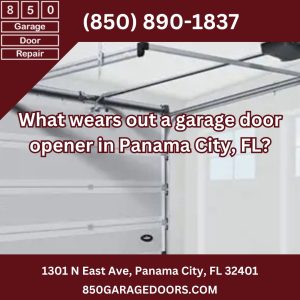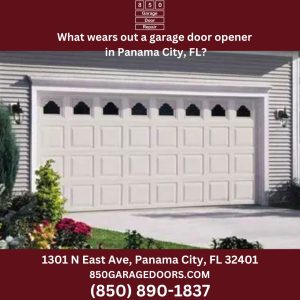Understanding How Garage Door Openers Work
The Main Components of a Garage Door Opener
A modern opener is a compact system that converts electrical energy into controlled lifting power. Key parts include the motor, a drive system such as chain, belt, or direct gear, a gear set that reduces speed and increases torque, a logic board that acts as the brain, safety sensors that read obstacles near the floor, and a receiver that listens to remotes or keypads. The opener is designed to guide and move a balanced door, not to drag a heavy or binding door. When the door is out of balance, the motor and gears take the load and wear much faster.
How Florida’s Climate Affects Garage Systems
Panama City homeowners live with warm temperatures, high humidity, sea breeze salt, and frequent storms. Humid air can condense on metal and circuit boards. Salt can accelerate corrosion on rails, springs, and hardware. Summer heat can make plastic housings and gears more brittle over time. Storm season increases the risk of voltage spikes that reach the opener through the home electrical system. All of these factors add cumulative stress that shows up as noise, vibration, or intermittent operation.
Common Causes of Garage Door Opener Wear and Tear
Everyday Use and Age
Most openers are rated by cycles. One cycle is one open and one close. A busy household can easily run dozens of cycles each day. Over years, even a perfectly maintained door will create predictable wear on brushes or bearings inside the motor and on the gear set that transfers power to the rail. Springs and rollers on the door also age. As those door parts get tired, the opener must work harder to move the same weight. That extra load ages the opener faster.
Heat and Humidity Damage
Moisture from humid air can collect inside the opener housing and on the logic board. Repeated wetting and drying can oxidize connectors and weaken solder joints. Bearings and metal gears are at risk for light surface rust that increases friction. In garages that trap heat, lubricants can thin out or gum up. Either extreme reduces protection between moving parts, which leads to noisy operation and accelerated wear.
Power Surges and Electrical Issues
Florida storms can produce quick jumps in voltage. Even brief spikes can punch through delicate paths on the circuit board. Symptoms include remotes that respond only sometimes, lights that flicker, or a sudden stop during travel. Repeated minor spikes that do not knock the opener out immediately can still shorten the life of capacitors and relays. Loose neutrals, shared circuits with large appliances, and aging outlets can add electrical noise that stresses the system each time the door moves.
Lack of Regular Maintenance
An opener is one part of a larger system. If tracks are dry or dirty, if rollers are flat spotted, or if hinges are stiff, the opener must pull harder. Without periodic lubrication on the door hardware and rail, tiny metal to metal contacts grind over time. Photo eye sensors need to be cleaned and kept aligned so the opener does not reverse unexpectedly. A balanced door is essential. If springs are weak, the motor will struggle and heat up, which shortens its life.
Misaligned or Worn Out Door Parts
Tracks that are slightly out of parallel or out of plumb create pinch points. Worn rollers can wobble and bind at those points. Bent hinges, loose fasteners at the top bracket, and a door that rubs the jamb in one corner all add drag. The opener tries to power through, which feels like heavy lifting to the motor and gears. Over time this causes gear teeth to chip, belts to stretch, or chains to whip.
Dust Debris and Salt Exposure
Coastal living brings fine salt crystals that drift into the garage. When mixed with dust and moisture, those crystals become an abrasive paste that works into rollers, bearings, and the rail. This paste increases friction and can etch metal surfaces. The result is a slow increase in effort and noise with each season unless you remove the buildup and restore clean lubrication.
Signs Your Garage Door Opener Is Wearing Out
Unusual Noises or Grinding Sounds
Grinding or squealing often points to dry bearings or a gear that has lost material. A rattle when the opener starts can be a loose chain or a belt with slack. A hum without movement can indicate a motor that is trying to start but cannot overcome friction or a seized part.
Slower or Jerky Door Movement
If the door pauses, starts in short bursts, or moves at a noticeably slower pace, the opener may be compensating for extra resistance. Jerky motion can also come from flat spot rollers, dented track, or a trolley that is catching in one area of the rail.
Remote or Keypad Malfunctions
Remotes that work only from close range or keypads that miss entries may signal weak batteries. If fresh batteries do not help, the receiver or logic board may be degrading. In a humid coastal environment, light corrosion on small contacts can cause intermittent control issues.
Increased Vibration During Operation
Vibration is a sign that the opener is fighting an imbalance or that the mounting is loose. Over time vibration accelerates wear across the system, loosening fasteners and stressing solder connections on the board. Address the cause early to protect the unit.
How to Extend the Life of Your Garage Door Opener
Regular Lubrication and Maintenance Schedule
Set a calendar reminder for light service at the change of seasons. Wipe the tracks, clean the rail, and apply a garage rated lubricant to rollers, hinges, and the opener drive where appropriate. Test the manual lift of the door to confirm balance. A well balanced door can be lifted by hand with steady effort. If it feels heavy or rushes down, schedule a spring assessment.
Protect Against Florida’s Weather
Use a high quality surge protector for the outlet that powers the opener. In a garage that gets damp, add gentle air movement with a fan or a small dehumidifier. Inspect weather seals at the bottom and sides of the door to keep salty spray and wind driven rain out. If your garage faces the coast, wipe down exposed metal after severe weather to remove salty residue.
Professional Tune Ups and Inspections
An annual or semiannual tune up by a trained tech can catch wear that is hard to see. The tech can measure spring tension, verify the opener force settings, check sensor alignment, and replace rollers or hinges before they fail. Early corrections cost less than major repairs that follow a breakdown.
Replacing Worn Parts Early
When a roller shows cracked seals or a hinge pin has play, replace it now rather than later. A small part that binds can cause the opener gear to fail. Replacing a photo eye bracket that will not hold position is cheaper than living with unexplained reversals that stress the system.
| Stress Factor | Action That Reduces Wear |
|---|---|
| High humidity and salt | Wipe metal, reapply lubricant, keep seals in good shape |
| Summer heat in closed garages | Promote airflow, avoid direct sunlight on opener housing |
| Frequent storms and lightning | Use surge protection and check outlets for solid contact |
| Grit from wind and traffic | Clean tracks and rail, then relubricate moving parts |
| Aging door hardware | Replace worn rollers and hinges and confirm door balance |
- Listen for new sounds at the start and end of travel
- Watch for uneven gaps under the door that suggest alignment issues
- Test the safety reversal every season with a light block under the door
- Keep remote batteries fresh and stored away from extreme heat
- Record service dates so trends in wear are easy to spot
When It Is Time to Replace Your Garage Door Opener
Age and Repair Costs
If your opener is older and needs frequent attention, it may be more practical to replace it rather than chase part after part. Look for a pattern of failures such as a gear kit one year followed by logic board problems the next. A string of issues often means the underlying stresses are still present. A new unit installed with a tuned and balanced door restores reliability.
Benefits of Upgrading to a Modern Opener
Newer units run quieter and smoother, which is helpful when bedrooms sit near or above the garage. Many models include soft start and soft stop that reduce shock across the system. Security features have improved with better rolling codes and motion sensing lights. Smart features can notify you if the door is left open and can allow secure access for family members without sharing a remote. When paired with a well maintained door, these advances reduce daily strain on the motor and drive.
Final Thoughts
Protecting Your Investment in Panama City’s Climate
Coastal living is hard on metal and electronics, yet most wear comes from preventable friction and imbalance. Keep the door hardware clean and lubricated. Confirm balance and sensor alignment. Add surge protection and control moisture where you can. Small habits add up to extra years of dependable operation.
When to Call a Local Garage Door Professional
Call a trusted local team when the door feels heavy, when the opener makes new sounds, or after a storm that causes electrical or water issues in the garage. A trained technician can separate door problems from opener problems and set up a plan that fits your home, your routine, and our coastal environment. If you want guidance that reflects real conditions in Bay County and nearby communities, the team at 850 Garage Doors is ready to help.
Conclusion
To sum up, the forces that wear out a garage door opener in Panama City include friction from an unbalanced or dirty door, moisture and salt that corrode parts, heat that thins lubricants, and storms that stress electronics. Addressing those causes with regular care, simple protective steps, and timely repairs will keep your opener running smoothly and safely. If you are weighing a repair or replacement, or you just want a checkup before storm season, reach out to 850 Garage Doors or explore more on their site. Clear information and careful service help you avoid surprise breakdowns and keep your family moving with confidence.



